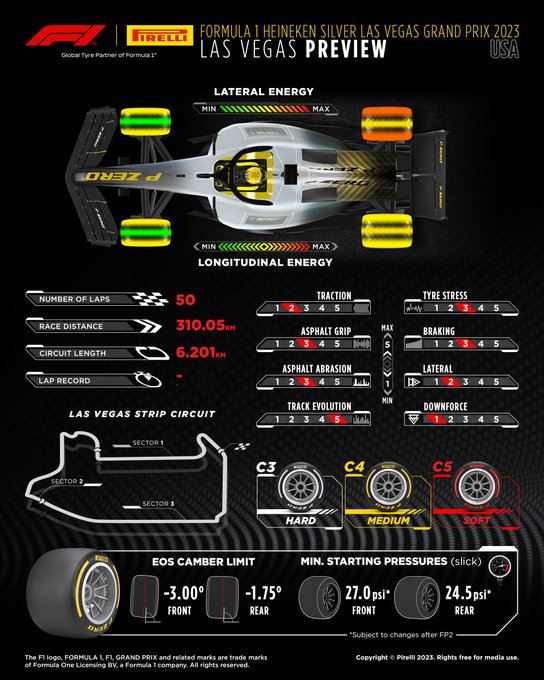- Login or Register
No account yet? Sign up
well hybrid F1 density altitude is swings and roundabouts - low DF means low drag
Why standing waves and tyre graining will be huge challenges in Vegas
Pirelli motorsport boss Mario Isola explains: “We had in Barcelona some pre-season tests with similar temperatures, but Barcelona is a different circuit where you put more energy into the tyre.
“Also, the asphalt I remember at that time was quite aggressive. It was before the last resurface. So, in Las Vegas, I believe we’re going to find it quite a unique situation compared to our historical data.”
“Are we able to keep the temperature in the tyre?” says Isola. “These factors could generate some graining.
“The track layout, we were working in advance compared to the usual procedure to get simulations in order to understand the severity of the circuit. And it's confirmed that the circuit is high speed but is a low severity in terms of corners because you don't have like in Silverstone high speed corners where you put a lot of energy.
“The Tarmac is not completely a road Tarmac but should be quite low roughness. So, Tarmac roughness, layout and colder temperature means that we are not generating a lot of heat into the tyre. That means that you cool down the tyre in the long straight.”
This thermal headache will only be more pronounced in the event of the field having to slow down for a virtual of full safety car.
He adds: “The point is that on the straight line, you generate standing waves [ripples in the sidewall as the tyre deform]. So, we need to protect the tyre from this high speed and the standing wave.”
High pressures will also be mandated. This will add some stiffness to the sidewall to make them less prone to the tyre-shaking sensation that comes with standing waves.
“We decided to select the three softest compounds simply because the temperatures are expected to be very low… We discussed [the tyre blankets], and I believe we don't need to allow them to do something different. We have the blankets. Seventy degrees is a temperature that allows you to go out with a tyre that is a good level of grip.”
There’s been plenty of winter testing where beanie hats and thick team-branded puffer coats were very much in vogue.
What’s different for Sin City, though, is that the 3.85-mile lap is dominated by long straights topped in smooth asphalt. Combine these with an absence of high-speed corners and it means the winter air will have plenty of time to chill the tyres, while there’s precious few areas for drivers to warm them back up again.
As for the race, people have already made their judgements before the cars have hit the pavement which is always stupid.
.JPower wrote: ↑13 Nov 2023, 16:31.As for the race, people have already made their judgements before the cars have hit the pavement
which is always stupid.

.It will be a major technical challenge for both the teams and us, as we head into this race with no real references apart from simulation. Nobody has ever actually driven the 6.12-kilometre Las Vegas Strip circuit before, which is second only to Spa in terms of overall length this year, characterised by three straights and 17 corners. The surface will be a mix of the usual street asphalt, especially on the actual Strip, as well as other parts that have been completely re-asphalted for the occasion; adding another unknown element. There won’t be any support races and the track will be opened again to normal traffic for long chunks of the day, which means that the surface won’t rubber in as usual and deliver improved grip.
We’re expecting the cars to run quite low levels of downforce, similar to Baku or indeed Monza: hitting a high top speed will be key to being competitive. All the sessions will take place at night, with unusual ambient and track temperatures for a race weekend; more similar to those found back when pre-season testing used to take place in Europe. Those long straights also make it harder to warm up tyres in qualifying, as well as keep them in the right window: the same challenge as seen in Baku, which will probably be more pronounced in Las Vegas.

There are no support races?!basti313 wrote: ↑13 Nov 2023, 16:48Well, I think one of the bad things is, that there is no F2 and F3 race. Same issue some years ago in Turkey...no rubbering in of the track. At least there are roadcars working the track a bit.
I would make it mandatory for new tracks to run F2 and F3 before or at the first weekend. Just to generate the necessary data and rubber.
Night? No. Coldest, yes. 5 degrees C for 1978 Canadian GP.haza wrote: ↑13 Nov 2023, 19:16This track is going to be intriguing any car that can quickly generate heat in the tyre will work well round here due to the cold temps I reckon there could be some nasty crashes this weekend with cars just losing the rear due to no heat in the brakes tyres and the track has no support series to rubber it in. have we ever raced somewhere this cold at night ?